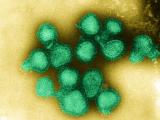Influenza activity in the United States increased again last week, with the Southwest as the major hot spot, the Centers for Disease Control and Prevention (CDC) reported today.
Six states—Arizona, California, New Mexico, North Carolina, Texas, and Utah—and Puerto Rico reported high flu activity as measured by the percentage of clinic visits for influenza-like illness (ILI), the agency said. Only two states and Puerto Rico had reported high activity the week before.
Flu cases were reported as geographically widespread in 21 states (plus Guam and Puerto Rico) last week, a big jump from 12 states the week before. The states with widespread activity were mainly in the Southwest, the Upper Midwest, and the Northeast.
Nationally, the share of clinic visits attributed to flu was 3.2%, compared with 3.1% the week before and a national baseline of 2.1%. All 10 regions were above their baselines for this measure.
Also still rising was the proportion of respiratory specimens that tested positive for flu, which reached 13.8%, up from 12% a week earlier.
Hospitalizations and deaths
The cumulative count of flu-related hospitalizations reached 5.8 per 100,000 population last week, up from 4.1 per 100,000 the week before, the CDC said. The rate in those 65 and older was 16.7 per 100,000 population, up from 12.7 per 100,000 the week before.
The share of deaths due to pneumonia and influenza, usually a lagging indicator of flu activity, was at 6.6% and 7.1% in the two reporting systems used by the CDC. Those figures remained just slightly below the epidemic thresholds for those systems.
One pediatric death was attributed to flu last week, raising the season total to 14.
Circulating strains
As for circulating flu strains, influenza A viruses outnumbered B viruses by 78% to 22% among tested specimens last week, and H1N1 viruses accounted for 81% of the type A isolates that were characterized, the CDC reported. That marked a sharp contrast from last year, when H3N2 viruses were dominant.
The CDC said the circulating viruses continue to match well with the strains used in this year's flu vaccine.
Yesterday the agency reported a preliminary estimate that the current vaccine is 59% effective overall, far better than last year's 19%, caused mainly by a mismatch between the circulating and vaccine strains of H3N2.
See also:
CDC FluView report
Feb 19 CIDRAP News item on previous FluView report
Feb 25 CIDRAP News story on flu vaccine effectiveness





















